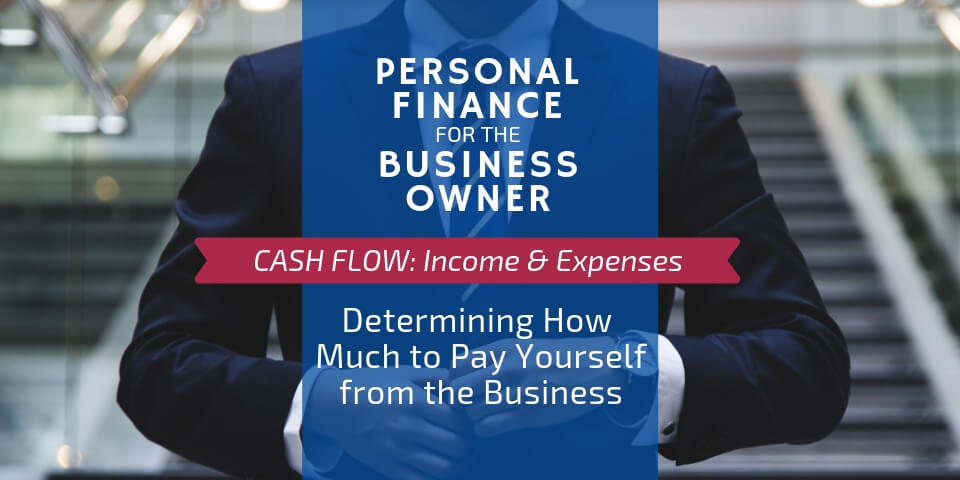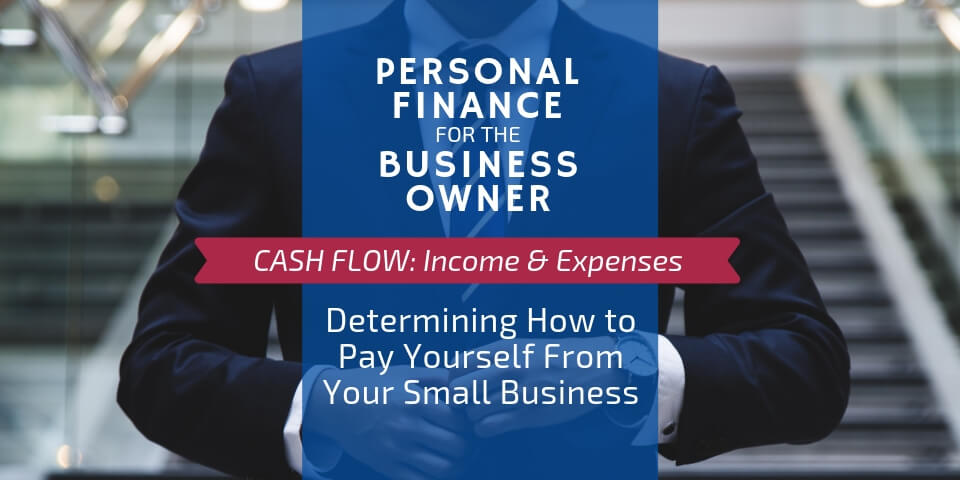
Why Personal Cash Flow Matters to the Business Owner
April 26, 2019
“How Much Should I Pay Myself?” The Business Owner’s Guide
May 1, 2019Determining How to Pay Yourself as a Small Business Owner

No matter whether you are just getting started in business or are a seasoned business owner, you need to revisit the method by which you are paying yourself. Perhaps, in the initial days of your business, you went through a period of time where you paid yourself only if there was a surplus in the business accounts. However, as your business matures and as cash flows become more predictable, you must gain control of your withdrawals. You need to plan on how to pay yourself as a business owner.
Podcast Time Index for “How Should I Pay Myself & How Frequently Should I Pay Myself from the Business”
- 01:27 – How Should I Pay Myself & How Frequently Should I Pay Myself from the Business
- 02:34 – The Basics
- 04:37 – Other Compensation Methods
- 04:48 – Guaranteed Payments vs. Distributions
- 06:08 – Why Does This Matter?
- 07:07 – W-2 vs. K-1
- 10:01 – How Often Should You Pay Yourself
- 12:22 – How to Move Away from Paycheck to Paycheck Living
- 15:20 – Wrap Up
Before I go any further, I want to remind you that I’m trying to simplify complex financial matters. I may be leaving out some information specific to your individual need. Therefore, visit your CPA and CFP® because they can give you further guidance about this particular topic.
How to Pay Yourself as a Small Business Owner
Did you know that the structure of your business, its entity selection, actually dictates how you get paid? Let me explain.
How to Pay Yourself if a C Corp, S Corp, or LLC taxed as an S or C Corp
If your business is structured as a C Corporation, an S Corporation, or an LLC taxed as an S or C Corp, then you are probably getting paid a salary. You’ve filled out a W-4 form, and you’re actually getting a paycheck and a W-2. You are having payroll taxes withheld, and the company is matching your FICA, FUTA, and SUTA, depending on your state of residency. Nevertheless, you are getting a paycheck.
How to Pay Yourself if a Sole Proprietor, Partnership, or LLC taxed as Sole Proprietor/Partnership
On the other hand, if you are a sole proprietor, a partnership, or an LLC taxed as a sole proprietor or partnership, then you are probably paying yourself an owner’s draw. If you aren’t receiving a W-2 or paycheck, then you are probably receiving a K-1, and you have to deal with self-employment taxes. In 2019, those taxes are roughly 15.3% of the first $128,400 you make. Since you aren’t having payroll taxes – FICA, FUTA, SUTA, Social Security, and Medicare – taken from a regular paycheck, then you’re probably making quarterly estimated tax payments depending on how your CPA or bookkeeper has you set up with the government.
Why “How You Pay Yourself” Matters
Now, if you are paying yourself on a regular schedule, your income could be considered a “guaranteed payment.” In other words, it’s guaranteed regardless of how well or poorly your business performs at any given time. However, if your owner’s draw is directly tied to your company’s profits, then you are probably receiving what’s called a “distribution.” Distributions are generally made relative to company earnings, whereas guaranteed payments are made irrespective of earnings.
If you are operating your business as an LLC, then you have some flexibility on how you get paid. Yet, you have to be careful because you don’t want to misclassify the type of payment you’re receiving. Why? Because under the new tax code, guaranteed payments are often not included as part of the QBI Deduction. That Qualified Business Income Deduction is potentially a 20% deduction on the income your company makes. Additionally, if you aren’t getting a salary or taking guaranteed payments from the company, then your retirement planning decisions also vary.
So how you pay yourself really does matter. If you are not sure what’s best for you and your personal tax plan, reach out to your business advisor, your financial planner, your retirement planner, and/or your CPA. Don’t be afraid to ask for professional help. Comprehensive wealth planning (holistic business and personal financial planning) matters more than you know.
How Can You Stop Living Paycheck to Paycheck?
I want to emphasize the fact that you NEED to ‘pay’ yourself. Ideally, you want the amount you pull out of the company to match the amount you’re spending in your specific personal budget. You don’t want to pay yourself more than you need. But you also don’t want to pay yourself last. Regardless, you want to have enough cash in your personal accounts to float you through emergencies or through unexpected expenses. You don’t want to live paycheck to paycheck. But how do you do that?
- The first thing you can do is set your spending amounts.
- Then, cut any expenses that don’t match that spending amount.
- As you cut expenses, you want to build your cash in your savings account to equal your largest single monthly expense. For example, if your $2,000 house payment is your biggest monthly expense, then you want to have an extra $2,000 in your savings account.
- Then, move the savings account outside of your control. Maybe you use that $2,000 to open a savings account in the next town over without receiving debit cards or checks for the account. You want to have access to the money, but you don’t want easy access to it.
- Finally, once you reach your savings target, then you’re going to build cash in your checking account to the same level.
Now, you have an emergency fund. Congratulations! You’ve moved from paycheck to paycheck, and now, you can determine how often you need to pay yourself from your business. If your budget dictates that you need to pay yourself weekly, biweekly, or monthly, do so. Just make sure you pay yourself so that you can stay afloat.
Now that we have determined how to pay yourself as a small business owner, in the next article, I’ll talk about determining the amount you should ‘pay’ yourself. Let’s continue to make our lives, at least, financially simple!



